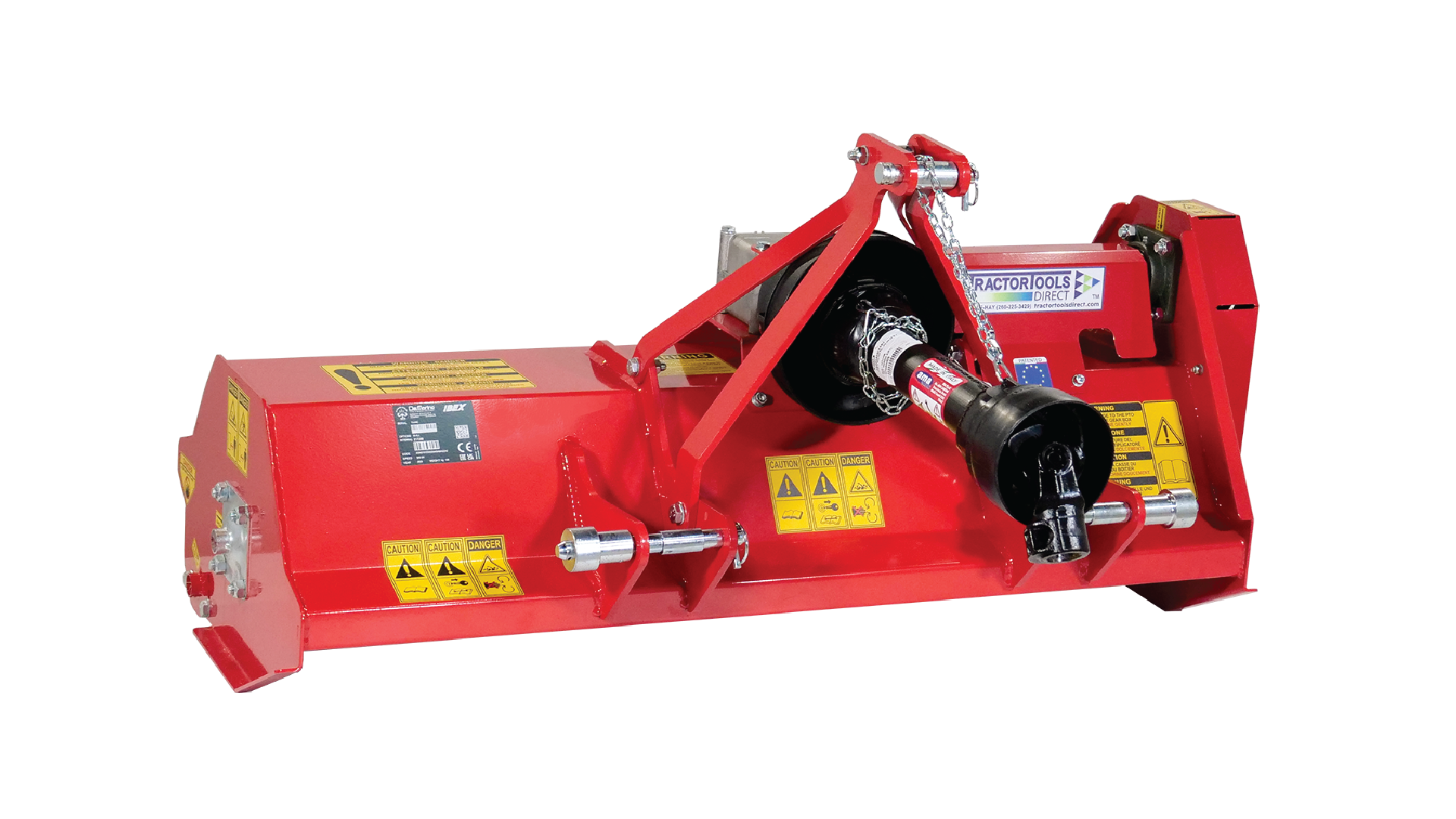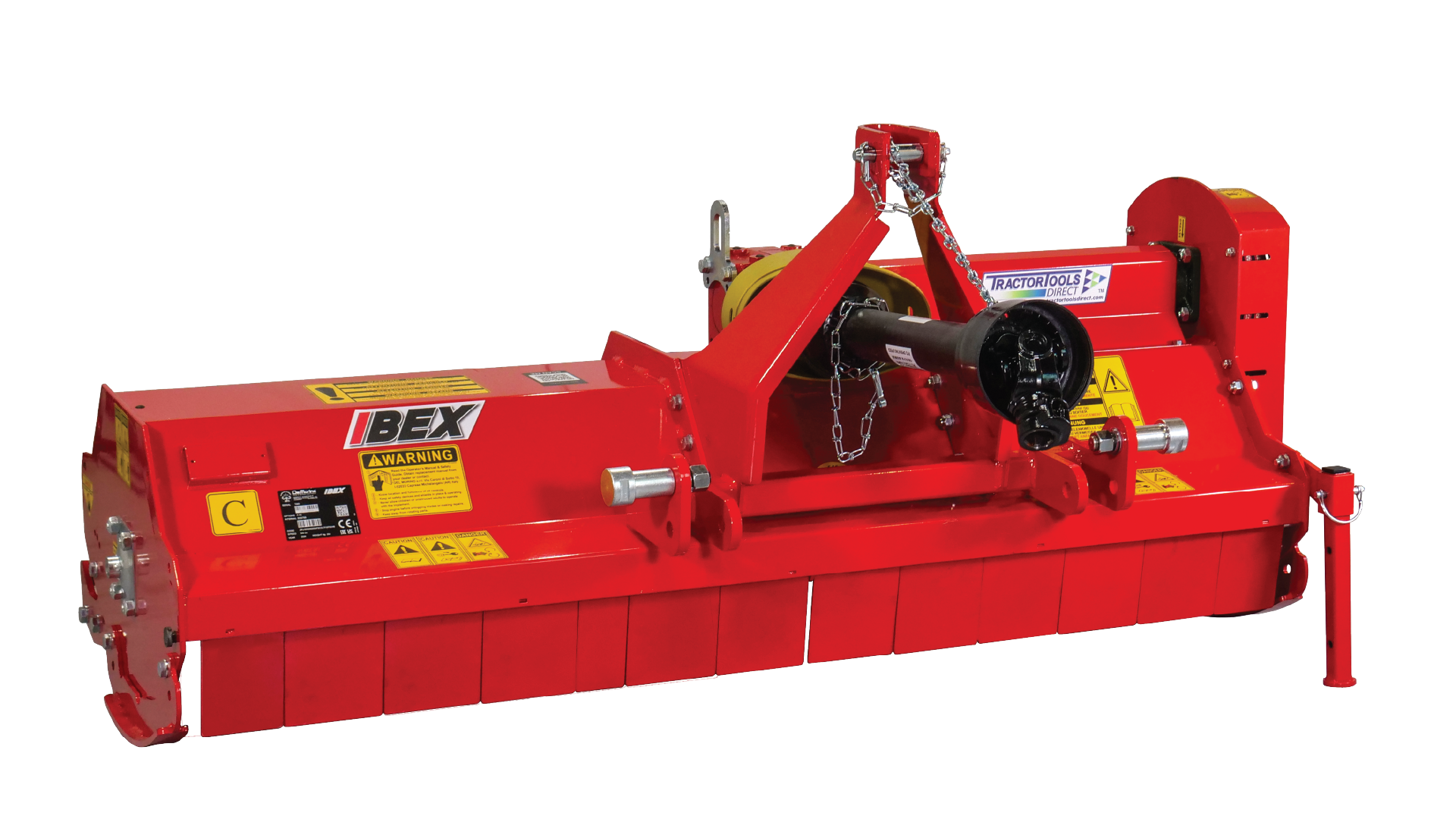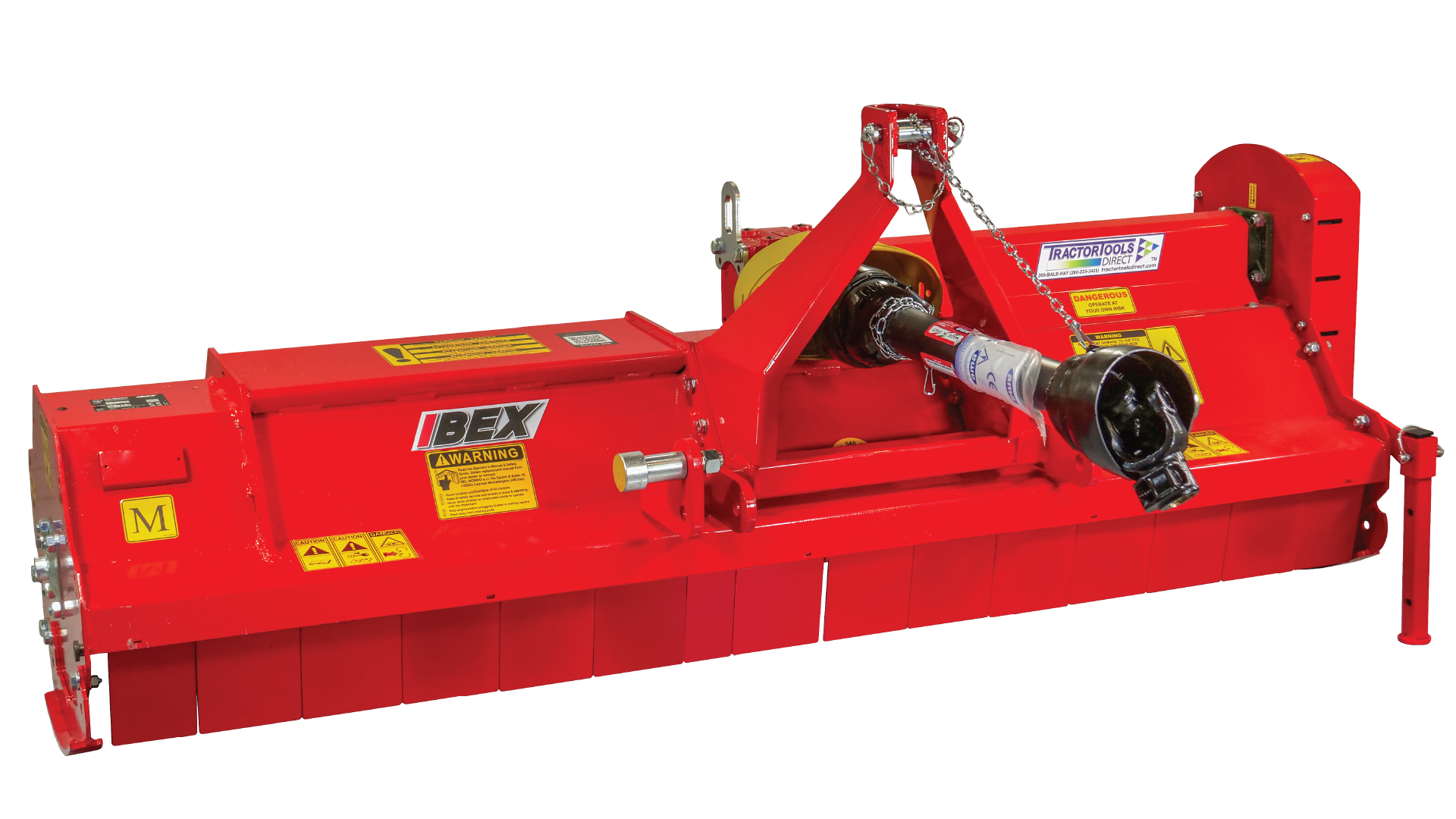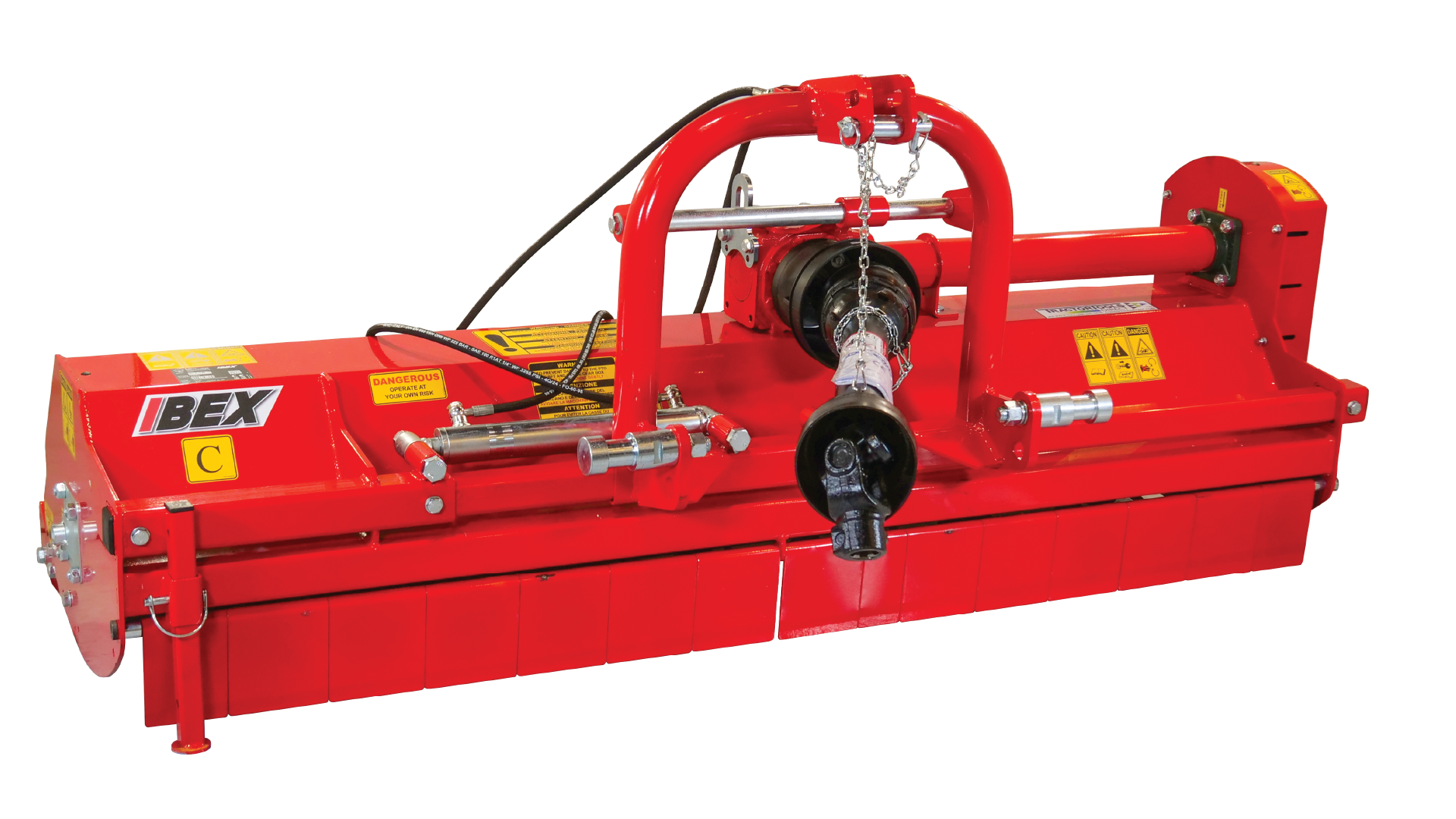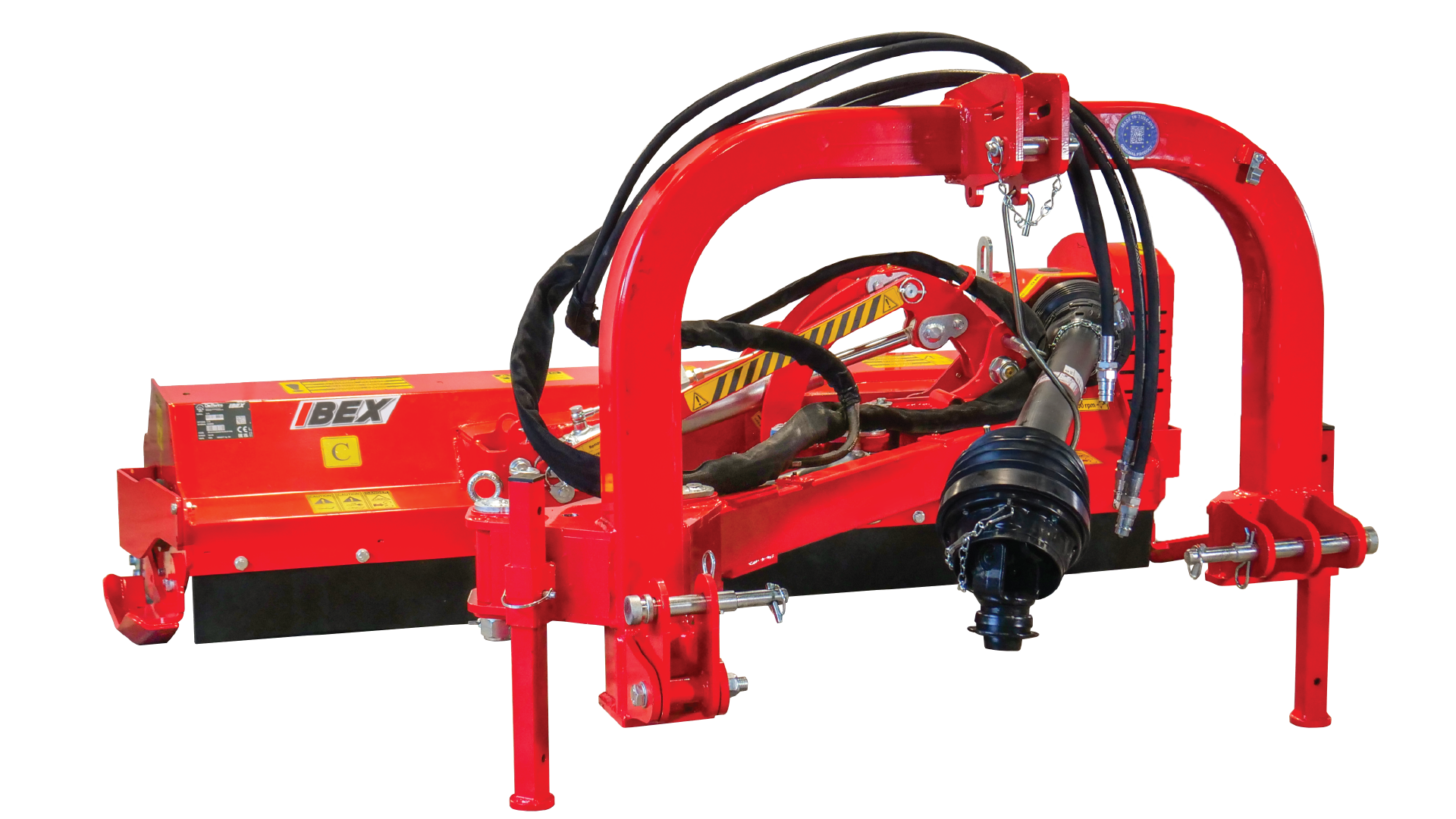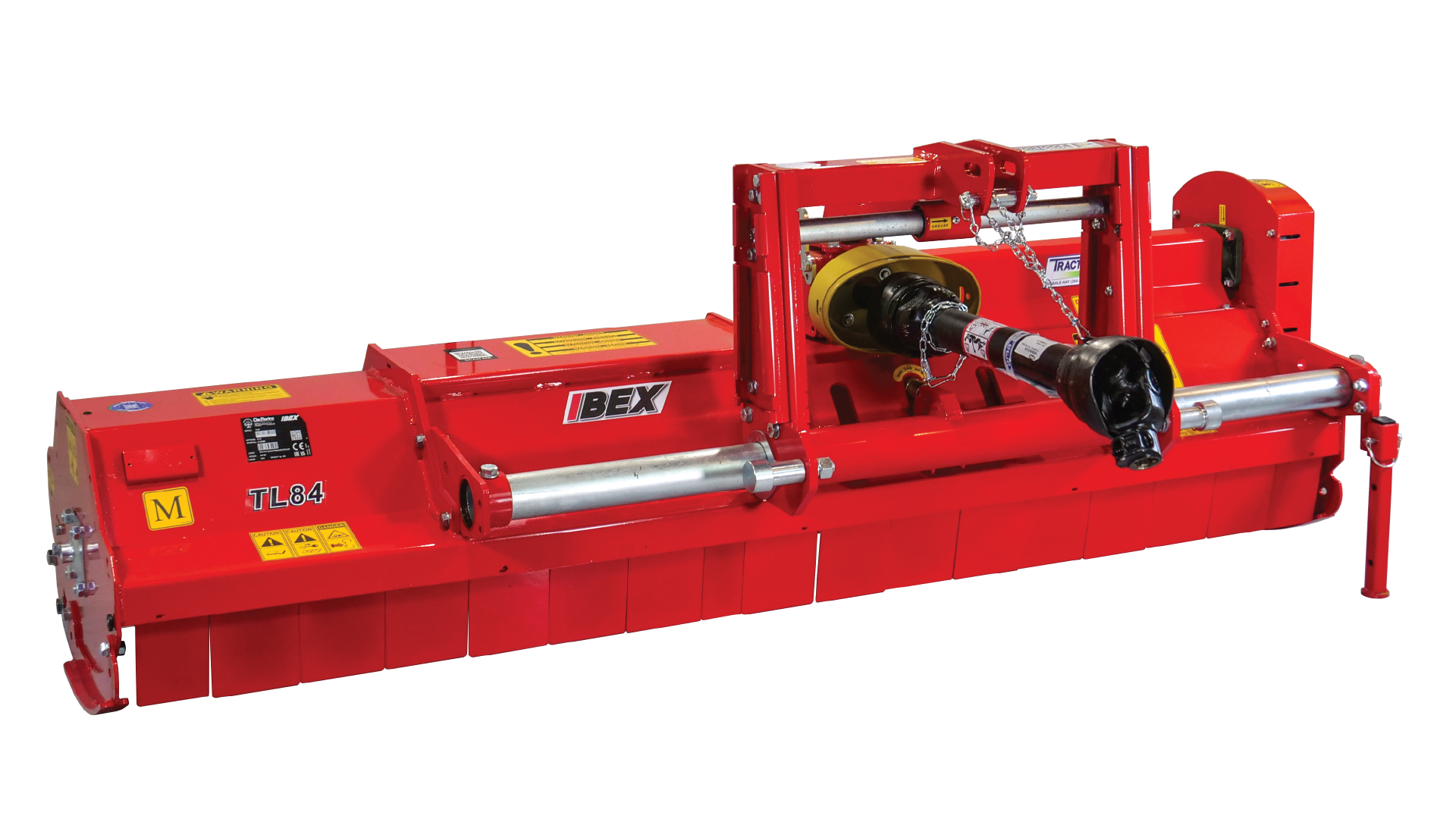



IBEX TX49E FLAIL MOWER
IBEX TS52 HYDRAULIC OFFSET FLAIL MOWER
Our Ibex TS52 Hydraulic Offset Flail Mower is the perfect choice for tough mowing situations that can’t be reached with a typical rear-mounted mower. Use your front loader hydraulics to adjust how far to offset the mower to the right, as well as how much to tilt it up or down, all with the PTO engaged!
IBEX TS62 FLAIL MOWER
The 5’-2” working width of the Ibex TS62 Flail Mower is a great size for compact utility tractors. Wide enough to cover the tractor’s wheel tracks, its offset can be adjusted easily during hookup. A flail mower is a superior implement for tough jobs like brush and pasture mowing. And flail mowers evenly distribute clippings, without clumps that kill the grass underneath. We’ve teamed up with Del Morino of Italy to provide a compact flail mower with features not found in the light-duty bargain brands.

IBEX TM73 FLAIL MOWER
With over 6 feet of cutting width, TM73 Flail Mower by Del Morino is ready to handle your big jobs. We're proud to offer an exclusive line of commercial grade flail mowers for a variety of tractors. A flail mower is a superior implement for tough jobs like brush and pasture mowing. And flail mowers evenly distribute clippings, without clumps that kill the grass underneath. We’ve teamed up with Del Morino of Italy to provide a compact flail mower with features not found in the light-duty bargain brands.
IBEX TM73 HYDRAULIC SIDE SHIFT FLAIL MOWER
The Ibex TM73 Hydraulic Side-Shift Flail Mower delivers powerful mowing performance with the added flexibility of 12" of lateral shift—adjustable on the fly from the tractor seat. Ideal for trimming along fences, buildings, or field edges, it lets you maintain a safe distance without sacrificing cutting precision.
IBEX TL73 HYDRAULIC OFFSET FLAIL MOWER
Our Ibex TL73 Hydraulic Offset Flail Mower is the perfect choice for tough mowing situations that can’t be reached with a typical rear-mounted mower. Use your front loader hydraulics to adjust how far to offset the mower to the right, as well as how much to tilt it up or down, all with the PTO engaged!
IBEX TL84 FLAIL MOWER
With 7 feet of cutting width, Ibex TL84 Flail Mower by Del Morino is ready to handle your big jobs. We're proud to offer an exclusive line of commercial grade flail mowers for larger utility tractors. A heavy-duty flail mower is a superior implement for tough jobs like brush and pasture mowing. And flail mowers evenly distribute clippings, without clumps that kill the grass underneath. We’ve teamed up with Del Morino of Italy to provide a compact flail mower with features not found in the light-duty bargain brands.

-
Lifetime Technical Support
When you buy from us, you're not just getting a piece of equipment—you’re gaining a lifelong partner. Our team of knowledgeable technicians is available to provide expert guidance and troubleshooting support for as long as you own your attachment. Whether you're dealing with a tricky installation or a tough job in the field, we're just a call or click away.
-
Over a Decade of Experience
With more than 10 years in the agriculture equipment industry, we’ve earned the trust of farmers, ranchers, and homesteaders across the country. Our deep product knowledge and field-tested insight ensure that we recommend only the right tools for your tractor—and your land.
-
Ships All Over the U.S.
Whether you're in the rolling hills of Pennsylvania or the wide plains of Texas, we’ve got you covered. We offer fast, reliable shipping to every state in the U.S., so you can get the attachments you need delivered straight to your door—no matter where you farm.
-
Parts in Stock
Downtime costs money. That’s why we maintain a robust inventory of replacement parts for every product we sell. No waiting weeks for parts to ship from overseas—our in-stock parts ensure that repairs and maintenance are fast, easy, and efficient, so you can keep your operations running smoothly.
-
2-Year Premium Warranty
Enjoy peace of mind with our industry-leading 2-year premium warranty on all compact tractor attachments. This comprehensive coverage protects your investment from manufacturing defects and ensures you're supported long after your purchase. We stand behind our products with confidence, so you can work your land without worry.
-
Free Support by Trained Staff
Have questions? Need help choosing the right implement? Our support team is trained specifically in compact tractor equipment and is ready to assist—at no extra cost. From first-time buyers to seasoned landowners, we provide clear, helpful answers that make your buying and ownership experience better.
Contact

Brush Hog or Flail Mower: Which One Is Best For My Operation?
In our communications with customers, we often field questions about the differences between brush hogs and flail mowers. Many people think that the two types of mowers are completely interchangeable; however, each type of mower is different enough to be suitable for different mowing conditions.
To understand the uses of each type of mower, it is necessary to have a basic understanding of how each mower works. Brush hogs are rotary mowers. This means that cutting is performed by horizontally spinning blades. In some rotary mowers, like many lawnmowers, the blades are regularly sharpened. However, since a brush hog is designed to work in tough conditions, its blades would dull ridiculously quickly. Therefore, a brush hog’s blades are heavy, thick and dull and rely on momentum to whack through growth up to an inch thick.
A flail mower cuts with “ flails”, y- or t-shaped blades, attached to a long shaft. This shaft, powered through PTO drive, runs parallel to the ground, and as it rotates these blades shred biomass. Cut material is held under the mower for a longer time allowing it to be further shredded, and then the finer clippings are distributed evenly across the full width of the mower. This ensures that clippings do not clump and pile, potentially killing regrowth and eventually leaving bare spots in the field.
Brush hogs are great for mowing large over-grown grassy areas and can tackle tall, thick grass with ease. They can be run at fairly high ground speeds, meaning more acreage can be covered in a given time. This increased production comes at the cost of a lower quality cut and the potential for clumping and piling of clippings. Brush hogs with their simple blades are also easy to maintain. However, another downside of the brush hog pertains to safety. With its rotary motion, objects can be thrown in any direction; therefore, mowing in areas with debris—rocks, trash, sticks—should be undertaken with great caution.
"Flail mowers are a better choice for areas of overgrown brush and vines, and their design reduces the risk of injury from flying debris."
Flail mowers excel at cutting vines and brush. This makes them the perfect choice for areas that are not only grassy but also overgrown with other types of vegetation. Their design does a nice job of mulching what is cut thus returning nutrients to the soil. Adding to their versatility, some models can be extended to the side and angled to cut ditches and banks. Their linear cut and design also reduces the risk of thrown debris making them a better choice for mowing areas with rocks, woody material and even litter, or anywhere people may be present nearby. If damaged, the flails are simple to replace.
In conclusion, brush hogs tend to be a better choice for large overgrown grassy fields and can handle such conditions with greater speed, though lower quality, than flail mowers. However, flail mowers are a better choice for areas of overgrown brush and vines, and their design reduces the risk of injury from flying debris. Additionally, the flail mower will give a better-quality cut and will disperse the clippings more evenly. When choosing the best mower for your operation be sure to keep these factors in mind.
Drum Mower? Flail Mower? Which do I need?
Here at Tractor Tools Direct we field quite a few phone calls, chats, and emails asking about different types of mowers and their uses. This blog will discuss the differences between the two types of mowers we carry–drum mowers and flail mowers–and explain why they are not interchangeable. They definitely have very different uses on a small farm.
A drum mower is a hay mower. Its purpose is to cut the stem of a crop at its base leaving the cut plant as unscathed and complete as possible. This allows for easy pick up by a hay baler with little material loss. The mown grasses produced by a drum mower are meant to be harvested, not left in the field to decompose. The thick piles of grass and/or legumes created by a drum mower will not easily decompose, and may hinder or even prohibit future pasture growth if not removed. In addition, a drum mower is not recommended for tough jobs like mowing brush or severely overgrown woody areas, due to its smaller, free swinging blades.
On the other hand, a flail moweris a multi-use mulching mower. Flail mowers are ideal machines for maintaining field edges, trails, pastures, and clearing overgrown areas and brush. Cut material is held under the mower allowing it to be shredded, and then the finer clippings are distributed evenly across the full width of the mower. This ensures that clippings do not clump and pile, potentially killing regrowth and eventually leaving bare spots in the field. However, flail mowers chop biomass too finely for pick up by a hay baler and thus cannot be used for hay production.
So if you are looking for a mower to produce hay, a drum mower is the perfect choice. If you are looking for a mower to handle tough property maintenance jobs, a flail mower is the way to go.
For more information on these mowers and others, please check out these past blogs:
- https://tractortoolsdirect.com/blog/brush-hog-or-flail-mower-which-one-is-best-for-my-operation/
- https://tractortoolsdirect.com/blog/drum-mowers-making-the-cut/
If you have further questions, please visit our website at https://tractortoolsdirect.com/ or give us a call at 260-BALE-HAY today!
The Use of Flail Mowers for Orchard and Vineyard Maintenance
Most people would think that the maintenance of trees and vines would be the most important consideration for orchard and vineyard operators. However, the care of the undergrowth below these stands is just as important. Let’s see how flail mowers, typically thought of as implements for pasture management, can be vital to the success of orchards and vineyards.
Cover crops are grown between vine and tree rows in vineyards and orchards for several reasons. Probably the most common reason is for erosion control—slowing the runoff of rain water and holding soil in place–especially in the hills of California. Other reasons include the addition of nitrogen and organic matter to the soil. In orchards and vineyards that are also marketed as tourist destinations, proper ground cover reduces the negative impact of foot traffic and enhances aesthetics.
Once a ground cover is chosen and established, its maintenance is crucial to maximize its benefits. Timely mowing is critical. Mowing encourages proper growth, spreading, and flowering of cover crops. It also removes tall weeds that might shade cover crops thus impeding their growth. Mowing shreds vine and tree prunings as well as dropped fruit and leaf litter thus also recycling nutrients from orchard and vineyard debris.
To tackle these tasks, flail mowers are a useful implement for vineyard and orchard operators. A flail mower cuts with “flails”, y- or t-shaped blades attached to a long shaft. This shaft, powered through PTO drive, runs parallel to the ground, and as it rotates these blades shred biomass and prunings. A second stationary shaft follows the first smoothing the freshly cut undergrowth and catching larger clippings that require more time near the blades for sufficient mulching. This allows flail mowers to easily tackle tough vines, branches and dropped fruit while also evenly distributing clippings and eliminating clumps that might kill the undergrowth beneath.
Tractor Tools Direct offers several models of flail mowers for our orchard and vineyard operators. However, our TM62 Hydraulic Offset Flail Mower is by far the most popular since it is the perfect choice for tough mowing situations that can’t be reached with a typical rear-mounted mower. In an orchard or vineyard it works as a standard rear-mounted flail mower, easily chopping through thick covercrops and vine and tree prunings.
This model of TM62 mower really shines in the offset position, allowing you to reach under overhanging branches and vines. This positioning can even be done on the fly as you cut making it easy to work around trees and among vine rows. Another plus of the offset position is that it allows you to cut overgrown areas without driving over the material first, resulting in a better, more complete cut.
Sources
Ingels, Chuck A. Cover cropping in vineyards: A Grower’s Handbook. Cooperative Extension, University of California, 1998.
“Tree Fruit: Practical Guide for Organic Apple Production.” University of Vermont. 2018.
“What is a Flail Mower, and is it For You?” LawnEQ Blog, 24 Aug. 2015.
Be On the Cutting Edge of Modern Market Gardening Using Raised Bed Systems: FULL-TILL, MINIMUM-TILL, and NO-TILL
Market gardening is the production of vegetables, fruits, flowers and other plants on a scale larger than a home garden, yet small enough that many of the principles of gardening are applicable. This is done in raised beds. It seems that the concept of raised bed gardening has become the latest trend in home gardening. However, growing vegetables in raised beds has been going on in market gardening for years. The modern raised beds used for market gardening have no frames, only soil mounded up to allow the soil to drain well and to warm in the spring months.
For those of you who are considering market gardening in raised beds let me begin with an overview of this gardening practice. Two common widths of these beds are 36” and 48” and whatever length is available for use. There are walkways between each that are normally 12” to 24” in width. Once the beds are formed and established, the preferred way of preparation for planting is accomplished with a tractor that has its wheels spaced at a width that allows them to run in the walkway and not in the bed. Only the mower, tillage tool, or planter operates in the bed at a width matching the planting bed. Once the beds are established, all planting, cultivation, and harvesting is accomplished while remaining in the walkway. This minimizes soil compaction and maximizes soil health.
From full-till to low-till to no-till, different approaches require different practices but with the same tools. The health (fertility) of the soil in raised beds is much more manageable than in row crop production of produce. This soil health management is accomplished with a practice known as regenerative farming. This farming method focuses on putting as much back into your soil as you take from it. It is a much more environmentally friendly method of farming than conventional row crop production. Essential tools for this method of market gardening are a flail mower and a power harrow. These machines are highly advantageous from an agronomic point of view: they contribute to a higher crop yield since they do not invert soil layers, but rather help to maintain the soil’s natural composition, structure, and biodiversity required in regenerative farming.
The flail mower gets its name from the use of flails, or blades, attached to its rotating horizontal drum. No matter your stance on tillage practices, terminating and then incorporating plant residue of a harvested crop or a cover crop in preparation for planting is a necessity in bed preparation. The flail mower is the perfect tool for this. Flail mowers chop the plant residue or cover crop and drop the mowed material in place creating a nice even mat of green mulch. Rotary mowers tend to leave large clumps of material and scatter it into the walkway wasting valuable compostable plant material. Unlike a rotary mower, a flail mower is able to mow at ground level or even just below ground level incorporating a bit of soil into the mat of plant material generated by the flail mower. Referred to as power composting, this process aids in the decomposition process and speeds up the release of carbon into the soil. For minimum till and no till practices, flail mowing in this manner leaves a planting bed that is ready for transplants.
If you are preparing a soil bed for transplanting or direct seeding, a power harrow is an absolute necessity. Whether your tillage practices are minimum till or full till, a power harrow is a specialized piece of tillage equipment used to prepare a perfect planting bed. The tillage depth of the power harrow is easily adjusted ranging from 1” to 6” and is well controlled by the rear roller. This allows you to stir only the top humus layer without inverting (turning over) the soil. This leaves the lower layers of soil undisturbed and does not mix the humus layer into the lower layers, maintaining the fertility of the top layer of soil where it is most beneficial for healthy plant growth and maintains soil health throughout the entire root zone. The power harrow leaves a level planting area with a mesh pattern that lightly firms the soil surface. This lightly firmed surface helps preserve moisture in the planting depth and leaves the soil perfectly crumbled for an ideal planting medium.
Another point that sets power harrows apart from rototillers is the fact that they don’t contribute to soil compaction in the way rototillers do. Rototillers, by the swiping motion against the soil level at the bottom of the tilled depth create soil compaction. This compaction occurs when soil pore spaces are eliminated by the swiping, squeezing and crushing action of the tines against the soil, creating compacted soil known as hard pan formation. With precise depth control to till only the upper humus layer of soil and vertical tillage of the power harrow, it doesn’t fragment the soil into the very fine particles that contribute to hardpan formation as extensively as rototillers. This also helps to maintain a healthy, nutrient rich seedbed which is aerated and drains water well.
The power harrow has multiple sets of tines that rotate on a vertical axis for complete tilling of the soil. It works the soil by stirring it instead of mixing. This maintains the profile of the topsoil leaving the upper layer, which is mostly humus, in the upper portion of the soil profile where it is most beneficial for plant growth. Unlike a rototiller, the power harrow does not invert (turn over) the lower layers of soil. With the tines rotating on a vertical axis there is no swiping motion against the soil. With the use of vertical tines, the soil is tilled on only one axis, providing aeration and porosity. This results in a healthy, nutrient rich seedbed which is well aerated and drains water well. The tilling depth is much easier to control with the power harrow than with a rototiller. This is very important for seed bed preparation when you only need the soil tilled to a depth of 1” to 2”. This prevents dormant weed seeds from being brought to the surface and leaves the soil with its original composition. This leaves the lower layers of soil undisturbed and does not mix the humus layer into the lower layers maintaining the fertility of the top layer of soil where it is most beneficial for healthy plant growth.
Tractor Tools Direct is proud to offer a full line of high-quality Ibex equipment built for use with compact and subcompact tractors. We’ve teamed up with Del Morino of Italy to provide compact flail mowers and power harrows with features not found in the light-duty bargain brands.
The Ibex TX52 Flail Mower has a working width of 52” that allows you to get over all popular bed widths. This mower is built to commercial-duty standards making it a mower suitable for use in all areas of your farm. The Ibex TX52 Flail Mower is suitable for tractors ranging from 20 to 40 HP. It is an ideal machine for maintaining field edges, trails, pastures, and clearing overgrown areas and brush. This mower comes equipped with standard Y blades capable of mowing woody material up to 2” in diameter and will also handle optional hammer blades.
The Ibex Power Harrows are offered in 3 models, the TX40, TS52 and TM64. The TX40 has a cultivating width of 35” with a leveling width of 40”. The TS52 has a cultivating width of 48” and a leveling width of 52”. The TM64 has a cultivating width of 60” and a leveling width of 64”. They are manufactured with Italian engineering and quality; the drive gear system has hardened steel gears that run in an oil bath and these units boast a maximum tilling depth of 6”. The vertical tines rotate in a horizontal pattern to stir up planting beds and smooth them out. The light mesh pattern it leaves behind is an attractive finish.
Tractor Tools Direct wants to help in your effort to be more productive, profitable, and environmentally conscious on your farm. We know that regenerative agriculture is the way forward for small farms across the country.
Give us a call today – (260) 225-3429.


